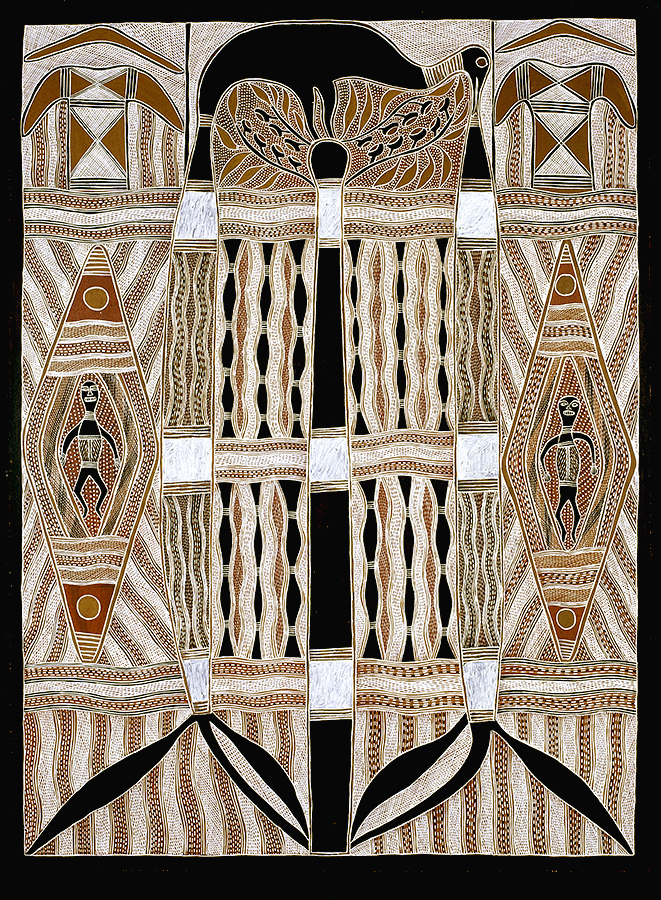Highlights from the ANU Art Collection: Wayilkpa Maymuru
Wayilkpa Maymuru
Mangalili clan, Djarrakpi homeland, Yirritja moiety, Dhuwala language, Ngaritjan skin | born 1975, Djarrakpi, Arnhem Land, Northern Territory
“It was in the wangarr, ancestral times, when the Guwak men, Munuminya and Yikawanga, siting under the shade of the sacred Marawili tree, instructed the ancestral koel cuckoo Guwak to lead the Maŋgalili people to this new place they had established for them at Djarrakpi.
Having seen the people settled in their new homeland they announced to the Maŋgalili their farewell, that they, the Guwak men were to travel out to sea, to a place in the sky and that they would become stars which would shine out of the night sky. So a canoe and paddles were made and their journey began by paddling down the Milngiya River which flows into the Blue Mud Bay near Djarrakpi. In the bay, at a place of significance, strong winds developed and capsized the canoe – the men drowned. At this place is the site of Yingalpiya, the freshwater crocodile’s nesting place. This same place is the spirit source for Maŋgalili people. The Guwak Men, it was said, had attempts made on them to be rescued.
A special log Milkamirri or Bandumul, containing mangrove worms offered itself as assistance. Ŋoykal the ancestral king fish is also manifest in this form. Even the rock cod they had caught for their journey offered assistance, as did Dhäla the sea creature.
It was to no avail however as the men had destined themselves as offerings, to the night sky where they and subsequent Maŋgalili souls are seen today in the Milky Way. These Maŋgalili souls atain their celestial position by means of possum fur string Burrkun that connects Djarrakpi at the site of the Marawili tree to the night sky. Miliyawuy or Milngiya as the Milky Way is also looked upon as the nesting place for the ancestral crocodiles Yingalpiya. The river itself is in the middle of the painting shown as it is today after it was sung into the sky by these Maŋgalili heroes – the Milky Way.”
— Wayilkpa Maymuru, Buku-Larrnggay Mulka Centre; 2024

Wayilkpa Maymaru’s father, Banapana and grandfather, Narritjin were distinguished Yolŋu artists from Northeast Arnhem Land, who established an outstation on Manggalili land at Djarrakpi during the 1970’s. Banapana and Narritjin Maymuru were the first Indigenous artists awarded the prestigious ANU Creative Arts Fellowship in 1978. Accompanied by Banapana’s wife, the artists spent three months in Canberra, making artworks and teaching students from the Canberra School of Art and ANU School of Anthropology.

Wayilkpa Maymuru’s Milŋiawuy depicts the same ancestral story as in Djarrakpi Landscape, a significant artwork made by Banapana in Canberra, which he gifted to the ANU at the culmination of the Creative Arts Fellowship. Wayilkpa Maymuru’s own interpretation of the Djarrakpi Landscape story uses the same elements in her own emblematic style, maintaining the artistic legacy inherited through her father and grandfather. In acquiring several artworks by Wayilkpa Maymuru in 2024, the Drill Hall Gallery maintains our commitment to the Yolngu community at Buku-Larrnggay Mulka Centre in Yirrkala, enriching the ANU Art Collection with the generational transference of these sacred stories.
The Drill Hall Gallery acknowledges the Ngunnawal and Ngambri peoples, the traditional custodians of the Canberra region, and recognises their continuous connection to culture, community and Country.
Contact
Close
Subscribe
Close
Close